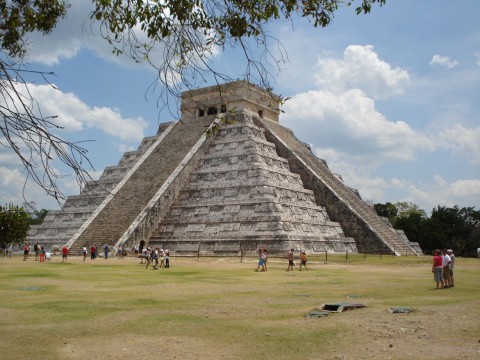the temple of kukulcan (el castillo). also know as chichen itza.
i’ve been to almost all of central amercica’s major pyramids, and being up there it is awe inspiring… imagining the short mayan priests 30 meter above ground, surveying the stars and the foliage that runs as far as the eye can see. still to this day all we have are but assumptions and theories on how these massive structures where actually built, still to this day the only answer we have to how two such far civilizations, in egypt and central america could have created such identical structures, and similar gods is all but “coincidence”! or more technically put:
“separated by the atlantic ocean and two thousand years, the pyramids of egypt and mexico call out to the imagination. they offer glimpses into romantically esoteric societies filled with secret rituals and exacting construction that even today cause us to ogle over them like voyeurs. so the question is not whether they still move us today, obviously they do. rather, the question is whether they moved each other, or failing that, did they dip their buckets into some common well of knowledge? of course there are seeming similarities between the artifacts and architecture of these geographically and temporally distant societies. the jade death mask of pacal could easily be compared to that of tut. likewise, the half-animal, half-human gods of egypt are similar, at their most basic level, to mesoamerican gods like quetzacoatl. and who can ignore the pyramids? unfortunately, despite these apparent similarities, they are unrelated to one another. not only were the mesoamerican pyramids built millennia after the those of egypt, they also did not share the same basic design or function. while the egyptian pyramids were private tombs meant to set the pharaoh off from the mainstream society of the day and protect him for eternity, the pyramids of mesoamerica, though sometimes used as tombs, were primarily public temples of ritual and celebration.”
the above argument does not even address the simplest of all issues, the general shape of the pyramids. that has been pushed aside by some as the basic shape one piles up stones. while i can see that being a possibility/coincidence, i don’t buy that given all the other similarities between the two… and no, piling up stones in a shape of a pyramid is not the obvious choice. placing a slab over 2 others (stone henge) is closer to a cave structure or other natural spaces man would have been familiar with. and yet we are to think making a fully perfect geometric shape, both accurately aligning with the stars, is a result of simply piling stones? rather insulting. it’s a riddle i’ve been entertaining myself with for the past few weeks. its exciting and fun. by dd
 a visual collective outlet of inspiration
a visual collective outlet of inspiration